Selection of Waste to Energy Technologies for Municipal Solid Waste Management—Towards Achieving Sustainable Development Goals
Abstract
:1. Introduction
Study Area
2. Research Methods
2.1. Identification of Criteria and Alternatives
2.2. Construction of Hierarchy Structure
2.3. Stakeholder Identification and Selection
2.4. Questionnaire Development and AHP Analysis
3. Results and Discussion
3.1. Waste Quality and Quantity
3.2. Weight Determination by Various Stakeholder Groups
3.3. Ranking of Alternatives
3.4. Sensitivity Analysis
4. Conclusions
Author Contributions
Funding
Institutional Review Board Statement
Informed Consent Statement
Data Availability Statement
Acknowledgments
Conflicts of Interest
Appendix A
Appendix B
| Scale 1 means equal importance | Scale 1/3 means weakly unimportance |
| Scale 3 means weakly importance | Scale 1/5 means definitely unimportance |
| Scale 5 means definitely importance | Scale 1/7 means very strongly unimportance |
| Scale 7 means very strongly importance | Scale 1/9 means absolutely unimportance |
| Scale 9 means absolutely importance | Scale 1/2, 1/4, 1/6 and 1/8 intermediate values between the two adjacent scale values |
| Scale 2, 4, 6 and 8 intermediate values between the two adjacent scale values |
References
- Hasan, M.M.; Rasul, M.G.; Khan, M.M.K.; Ashwath, N.; Jahirul, M.I. Energy Recovery from Municipal Solid Waste Using Pyrolysis Technology: A Review on Current Status and Developments. Renew. Sustain. Energy Rev. 2021, 145, 111073. [Google Scholar] [CrossRef]
- Khan, A.H.; López-Maldonado, E.A.; Khan, N.A.; Villarreal-Gómez, L.J.; Munshi, F.M.; Alsabhan, A.H.; Perveen, K. Current Solid Waste Management Strategies and Energy Recovery in Developing Countries—State of Art Review. Chemosphere 2022, 291, 133088. [Google Scholar] [CrossRef] [PubMed]
- Fasihi, H.; Parizadi, T. Analyzing Household’s Environmental Behavior on Solid Waste Management and Its Relations with Population and Housing Characteristics (The Case: Amlash City, Iran). J. Environ. Manag. 2021, 292, 112686. [Google Scholar] [CrossRef] [PubMed]
- Ferraz de Campos, V.A.; Silva, V.B.; Cardoso, J.S.; Brito, P.S.; Tuna, C.E.; Silveira, J.L. A Review of Waste Management in Brazil and Portugal: Waste-to-Energy as Pathway for Sustainable Development. Renew. Energy 2021, 178, 802–820. [Google Scholar] [CrossRef]
- Sridhar, A.; Kapoor, A.; Senthil Kumar, P.; Ponnuchamy, M.; Balasubramanian, S.; Prabhakar, S. Conversion of Food Waste to Energy: A Focus on Sustainability and Life Cycle Assessment. Fuel 2021, 302, 121069. [Google Scholar] [CrossRef]
- Ferronato, N.; Torretta, V. Waste Mismanagement in Developing Countries: A Review of Global Issues. Int. J. Environ. Res. Public Health 2019, 16, 1060. [Google Scholar] [CrossRef]
- Kober, T.; Schiffer, H.W.; Densing, M.; Panos, E. Global Energy Perspectives to 2060—WEC’s World Energy Scenarios 2019. Energy Strategy Rev. 2020, 31, 100523. [Google Scholar] [CrossRef]
- Pandey, A.; Asif, M. Assessment of Energy and Environmental Sustainability in South Asia in the Perspective of the Sustainable Development Goals. Renew. Sustain. Energy Rev. 2022, 165, 112492. [Google Scholar] [CrossRef]
- Zhang, G.; Nuruzzaman, M.; Su, B. Nexus between Household Energy Consumption and Economic Growth in Bangladesh (1975–2018). Energy Policy 2021, 156, 112420. [Google Scholar] [CrossRef]
- Islam, M.S.; Al-Amin, A.Q.; Sarkar, M.S.K. Energy Crisis in Bangladesh: Challenges, Progress, and Prospects for Alternative Energy Resources. Util. Policy 2021, 71, 101221. [Google Scholar] [CrossRef]
- Das, N.K.; Chakrabartty, J.; Dey, M.; Gupta, A.K.S.; Matin, M.A. Present Energy Scenario and Future Energy Mix of Bangladesh. Energy Strategy Rev. 2020, 32, 100576. [Google Scholar] [CrossRef]
- Akter, H.; Howlader, H.O.R.; Nakadomari, A.; Islam, M.R.; Saber, A.Y.; Senjyu, T. A Short Assessment of Renewable Energy for Optimal Sizing of 100% Renewable Energy Based Microgrids in Remote Islands of Developing Countries: A Case Study in Bangladesh. Energies 2022, 15, 1084. [Google Scholar] [CrossRef]
- Does Energy Consumption Reinforce Environmental Pollution? Evidence from Emerging Asian Economies. J. Environ. Manag. 2021, 297, 113272. [CrossRef] [PubMed]
- Islam, K.M.N. Municipal Solid Waste to Energy Generation in Bangladesh: Possible Scenarios to Generate Renewable Electricity in Dhaka and Chittagong City. J. Renew. Energy 2016, 2016, 1712370. [Google Scholar] [CrossRef]
- Islam, K.M.N.; Jashimuddin, M. Reliability and Economic Analysis of Moving towards Wastes to Energy Recovery Based Waste Less Sustainable Society in Bangladesh: The Case of Commercial Capital City Chittagong. Sustain. Cities Soc. 2017, 29, 118–129. [Google Scholar] [CrossRef]
- Yong, Z.J.; Bashir, M.J.K.; Ng, C.A.; Sethupathi, S.; Lim, J.W.; Show, P.L. Sustainable Waste-to-Energy Development in Malaysia: Appraisal of Environmental, Financial, and Public Issues Related with Energy Recovery from Municipal Solid Waste. Processes 2019, 7, 676. [Google Scholar] [CrossRef]
- Qazi, W.A.; Abushammala, M.F.M.; Azam, M.H. Multi-Criteria Decision Analysis of Waste-to-Energy Technologies for Municipal Solid Waste Management in Sultanate of Oman. Waste Manag. Res. 2018, 36, 594–605. [Google Scholar] [CrossRef] [PubMed]
- Yap, H.Y.; Nixon, J.D. A Multi-Criteria Analysis of Options for Energy Recovery from Municipal Solid Waste in India and the UK. Waste Manag. 2015, 46, 265–277. [Google Scholar] [CrossRef]
- Rahman, S.M.S.; Azeem, A.; Ahammed, F. Selection of an Appropriate Waste-to-Energy Conversion Technology for Dhaka City, Bangladesh. Int. J. Sustain. Eng. 2017, 10, 99–104. [Google Scholar] [CrossRef]
- Marzia, S.; Sakib, M.S. Ranking of Technologies for Energy Recovery from Municipal Solid Waste in Bangladesh Using the Analytic Hierarchical Process (AHP): A Case Study. In Proceedings of the International Conference on Industrial Engineering and Operations Management, Pilsen, Czech Republic, 23–26 July 2019. [Google Scholar]
- Kurbatova, A.; Abu-Qdais, H.A. Using Multi-Criteria Decision Analysis to Select Waste to Energy Technology for a Mega City: The Case of Moscow. Sustainability 2020, 12, 9828. [Google Scholar] [CrossRef]
- Alao, M.A.; Ayodele, T.R.; Ogunjuyigbe, A.S.O.; Popoola, O.M. Multi-Criteria Decision Based Waste to Energy Technology Selection Using Entropy-Weighted TOPSIS Technique: The Case Study of Lagos, Nigeria. Energy 2020, 201, 117675. [Google Scholar] [CrossRef]
- Agbejule, A.; Shamsuzzoha, A.; Lotchi, K.; Rutledge, K. Application of Multi-Criteria Decision-Making Process to Select Waste-to-Energy Technology in Developing Countries: The Case of Ghana. Sustainability 2021, 13, 12863. [Google Scholar] [CrossRef]
- Chattogram District. Available online: http://www.chittagong.gov.bd/en (accessed on 17 December 2021).
- Chen, Y.; Cheng, J.J.; Creamer, K.S. Inhibition of Anaerobic Digestion Process: A Review. Bioresour. Technol. 2008, 99, 4044–4064. [Google Scholar] [CrossRef]
- Waste-to-Energy Options in Municipal Solid Waste Management.). Available online: https://www.giz.de/en/downloads/GIZ_WasteToEnergy_Guidelines_2017.pdf (accessed on 5 September 2022).
- Intharathirat, R. Sustainable Municipal Solid Waste Management Systems for Small and Medium Sized Cities in Thailand. Ph.D. Thesis, Asian Institute of Technology, Khlong Nueng, Pathumthani, Thailand, 2017. [Google Scholar]
- Hartmann, H.; Ahring, B.K. Anaerobic Digestion of the Organic Fraction of Municipal Solid Waste: Influence of Co-Digestion with Manure. In Renewable Energy; Routledge: London, UK, 2018; pp. 294–307. [Google Scholar] [CrossRef]
- Intharathirat, R.; Abdul Salam, P. Valorization of MSW-to-Energy in Thailand: Status, Challenges and Prospects. Waste Biomass Valorization 2016, 7, 31–57. [Google Scholar] [CrossRef]
- Manuals. Super Decisions. Available online: https://www.superdecisions.com/manuals/index.php?section=2_X (accessed on 5 September 2022).
- Arunprakash, N. Municipal Solid Waste to Energy: A Case Study of Jaffna District, Sri Lanka. Master Thesis, Asian Institute of Technology, Khlong Nueng, Pathumthani, Thailand, 2016. [Google Scholar]
- Arun Prakash, K.; Suresh, M.; Vengataasalam, S. A New Approach for Ranking of Intuitionistic Fuzzy Numbers Using a Centroid Concept. Math. Sci. 2016, 10, 177–184. [Google Scholar] [CrossRef]
- Thitame, S.N.; Pondhe, G.M.; Meshram, D.C. Characterisation and Composition of Municipal Solid Waste (MSW) Generated in Sangamner City, District Ahmednagar, Maharashtra, India. Environ. Monit. Assess. 2009, 170, 1–5. [Google Scholar] [CrossRef]
- Lessons from Municipal Solid Waste Processing Initiatives in India. Available online: https://www.researchgate.net/publication/242309986_LESSONS_FROM_MUNICIPAL_SOLID_WASTE_PROCESSING_INITIATIVES_IN_INDIA (accessed on 5 September 2022).
- IPE. Management of Solid Wastes in Indian Cities—Draft Report; Infrastructure Professionals Enterprises Pvt. Ltd.: New Delhi, India, 2006. [Google Scholar]
- Professionals Enterprises Pvt. Ltd., New Delhi; Abba, A.H.; Noor, Z.Z.; Yusuf, R.O.; Din, M.F.M.D.; Hassan, M.A.A. Assessing Environmental Impacts of Municipal Solid Waste of Johor by Analytical Hierarchy Process. Resour. Conserv. Recycl. 2013, 73, 188–196. [Google Scholar] [CrossRef]
- Adenuga, O.T.; Mpofu, K.; Modise, K.R. An Approach for Enhancing Optimal Resource Recovery from Different Classes of Waste in South Africa: Selection of Appropriate Waste to Energy Technology. Sustain. Futures 2020, 2, 100033. [Google Scholar] [CrossRef]
- Babalola, M.A.; Lin, Y.-P.; Chang, C.-Y. A Multi-Criteria Decision Analysis of Waste Treatment Options for Food and Biodegradable Waste Management in Japan. Environments 2015, 2, 471–488. [Google Scholar] [CrossRef] [Green Version]
- Hanan, D.; Burnley, S.; Cooke, D. A Multi-Criteria Decision Analysis Assessment of Waste Paper Management Options. Waste Manag. 2013, 33, 566–573. [Google Scholar] [CrossRef]
- Haque, H.M.E.; Dhakal, S.; Mostafa, S.M.G. An Assessment of Opportunities and Challenges for Cross-Border Electricity Trade for Bangladesh Using SWOT-AHP Approach. Energy Policy 2020, 137, 111118. [Google Scholar] [CrossRef]
- Joel, S.; Molua Ernest, L.; Ajapnwa, A. Application of Analytic Hierarchy Process Decision Model for Solid Waste Management Strategy in Yaoundé, Cameroon. J. Solid Waste Technol. Manag. 2019, 45, 502–517. [Google Scholar] [CrossRef]
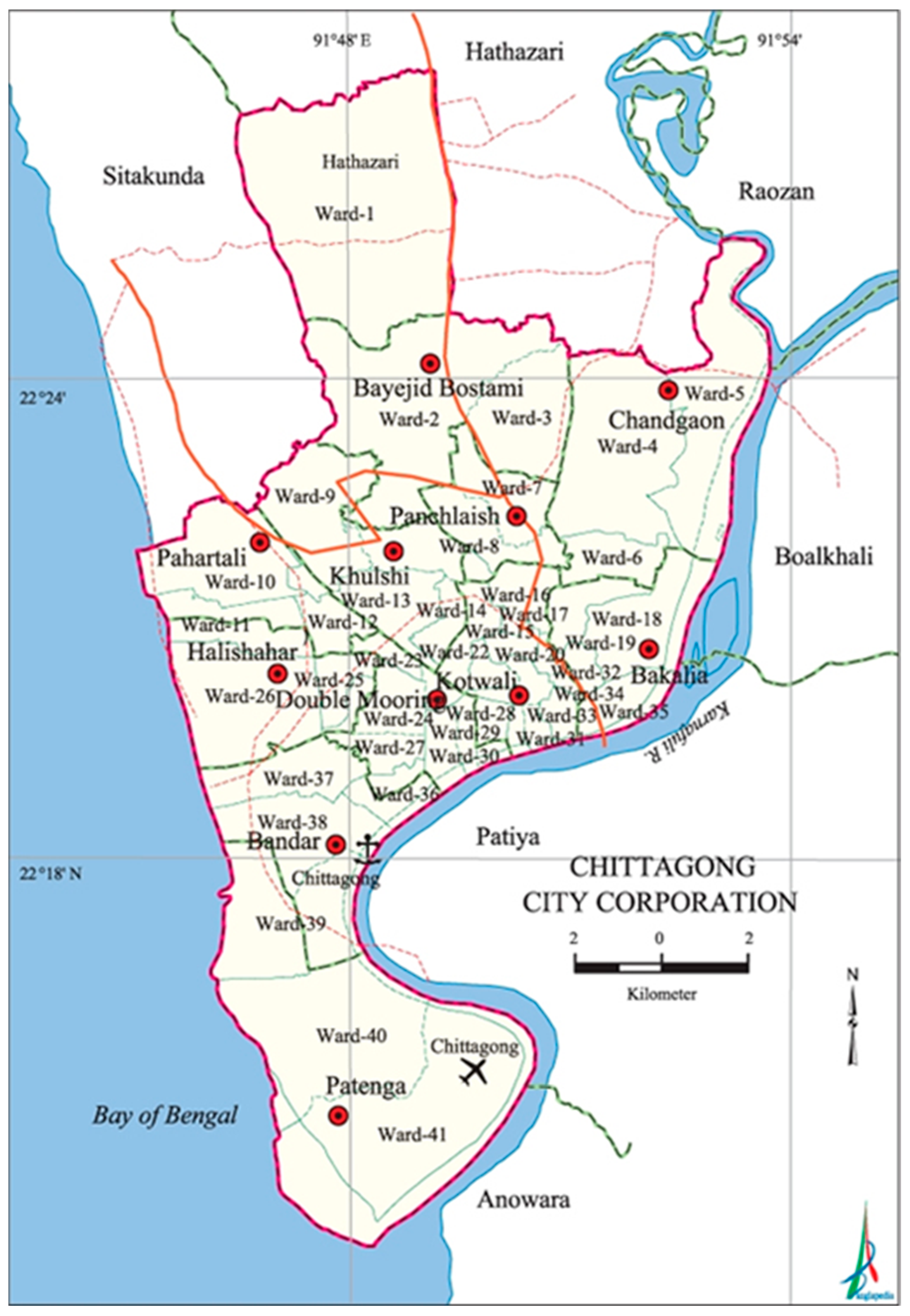
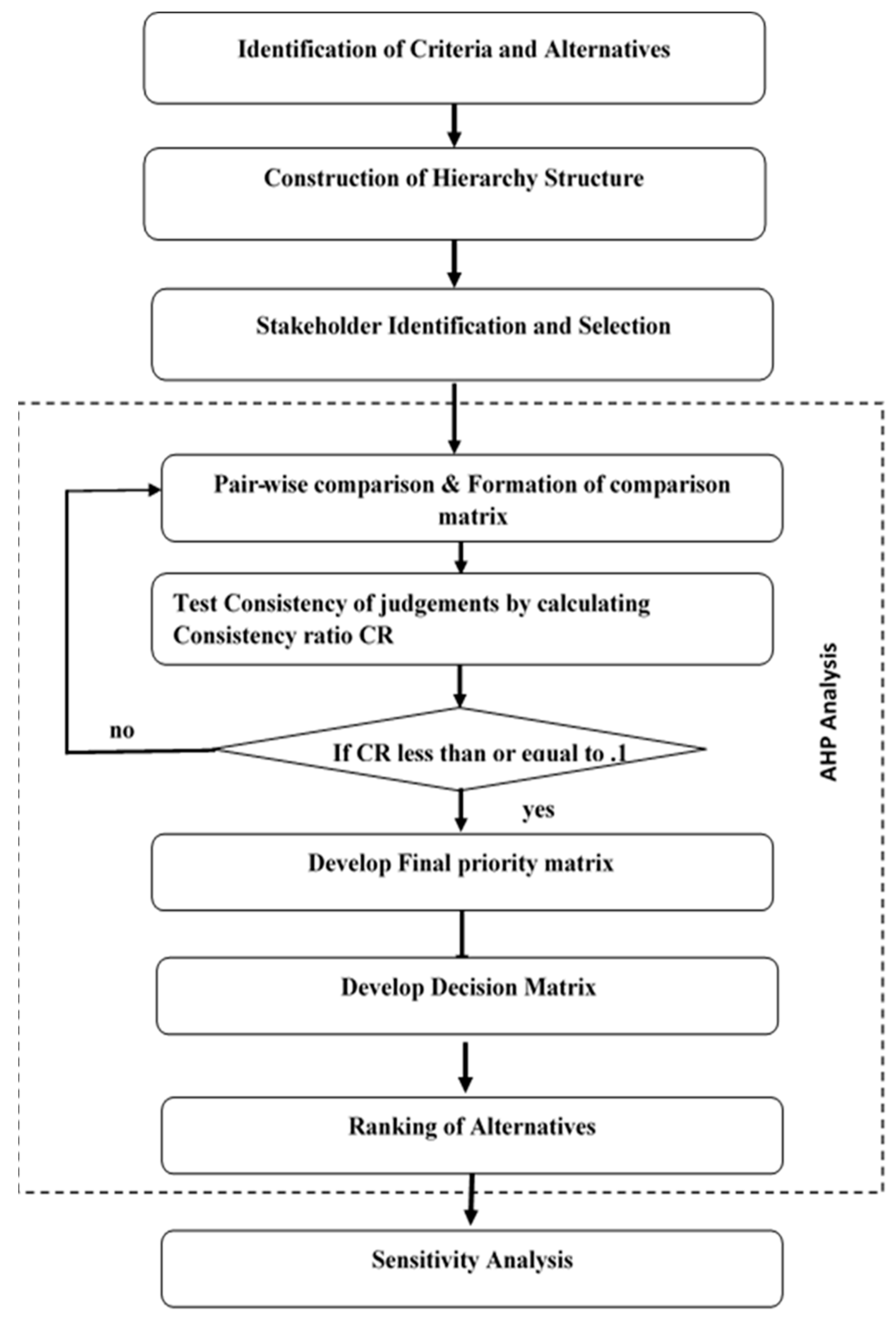
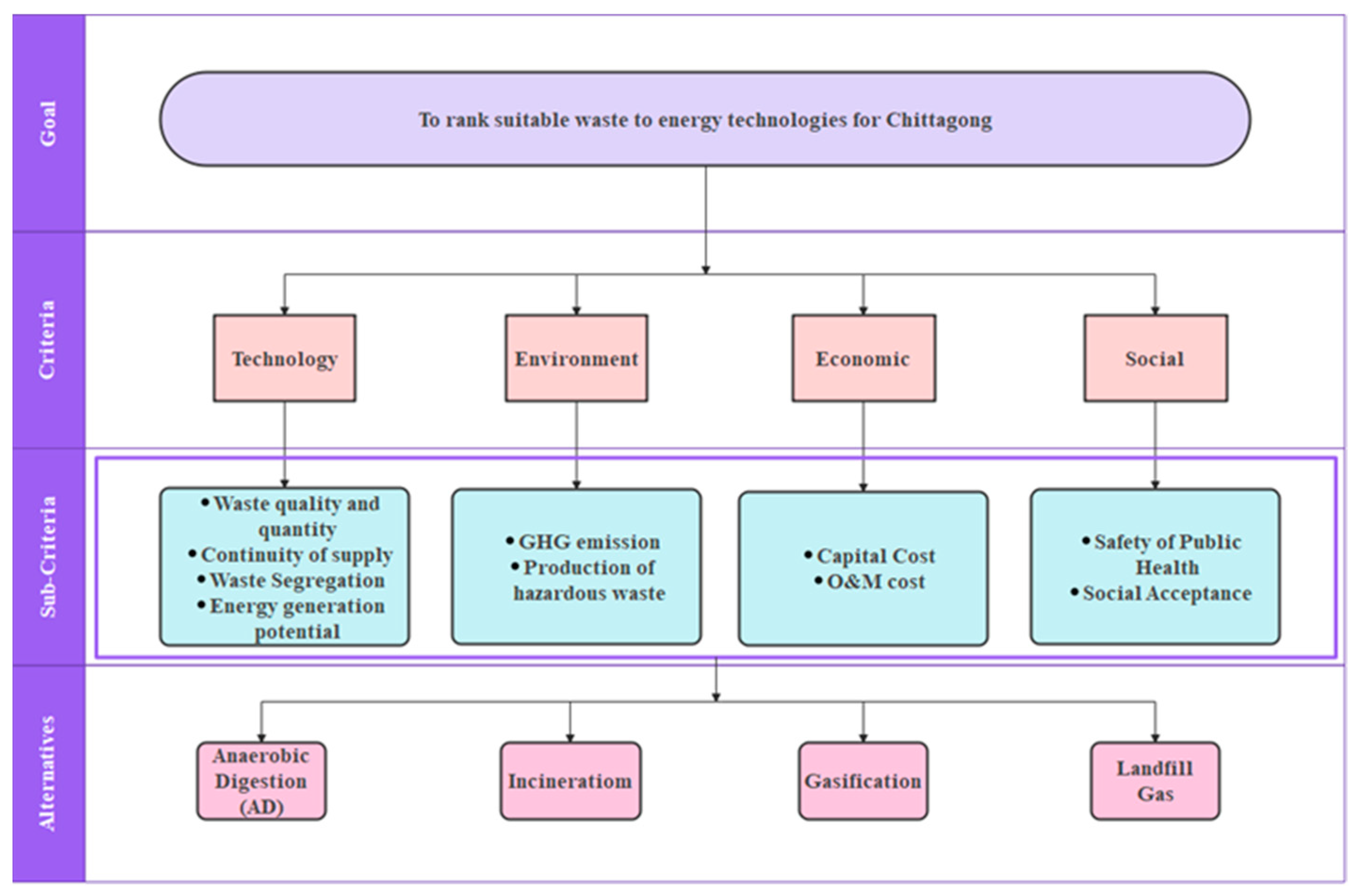


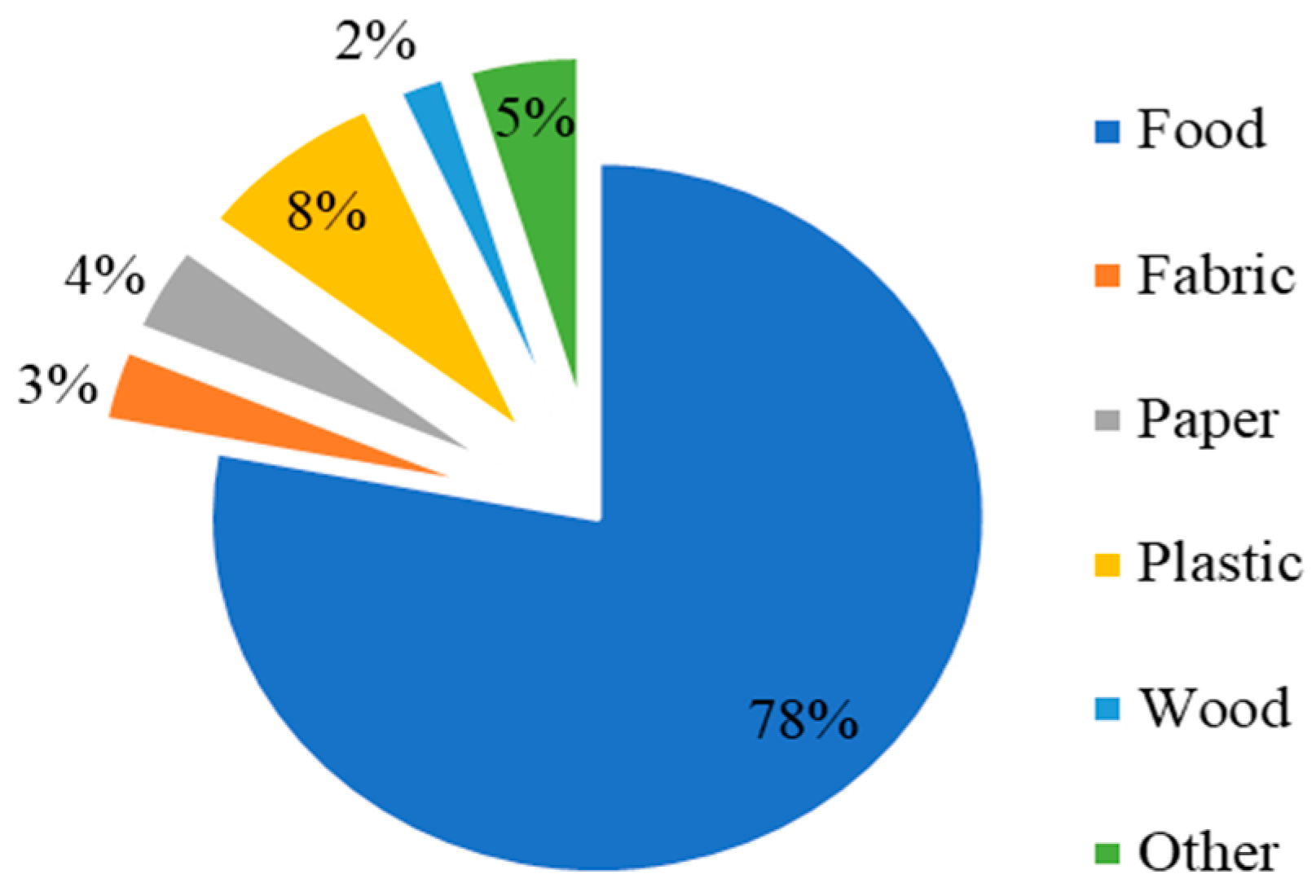

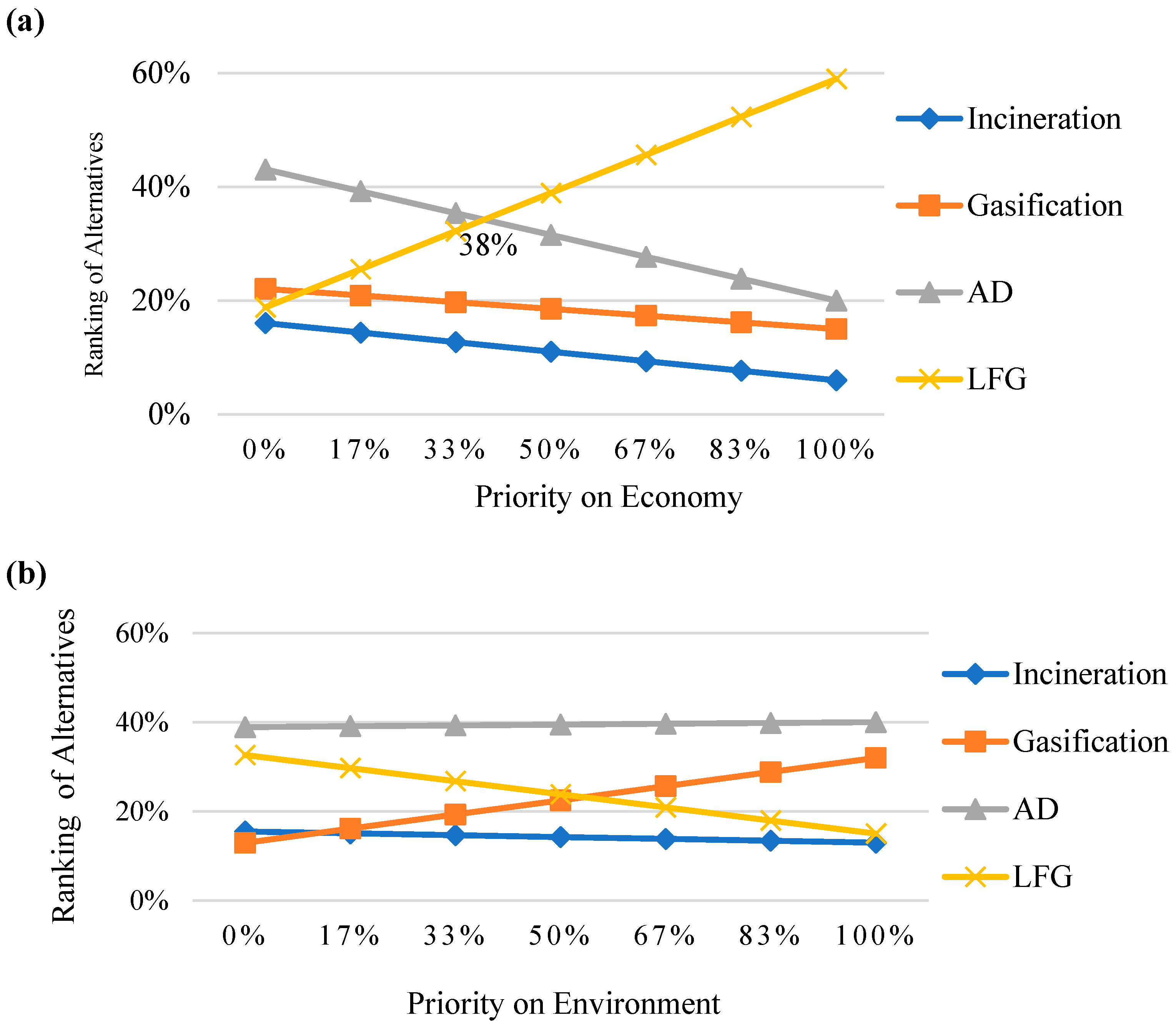

| References | Yap et al., 2015 [18] | Rahman et al., 2017 [19] | Qazi et al., 2018 [17] | Marzia et al., 2019 [20] | Yong et al., 2019 [16] | Kurbatova et al., 2020 [21] | Alao et al., 2020 [22] | Agbejule et al., 2021 [23] |
|---|---|---|---|---|---|---|---|---|
| Method Applied | AHP-BOCR | AHP | AHP | AHP | SWOT | AHP | TOPSIS | AHP |
| Stake holders | Academic experts | Academic experts | Waste Management Department, Academic experts | - | - | Academics, Waste Professionals, Decision Makers of Federal and Local Authorities, Energy Specialist, Members of International donating agencies in Moscow, Graduate Researchers | - | Academics, Waste Professional, Graduate researchers in bioenergy and waste management on Ghana, Energy Regulator, Decision Maker |
| Alternatives considered | Incineration, Gasification, AD, LFG, RDF | AD, Plasma Gasification, Pyrolysis | Incineration, gasification, plasma arc gasification, pyrolysis, AD, Fermentation, TDP, HTC | Incineration, AD, LFG | AD, incineration, Plasma gasification, Pyrolysis, LFG | LFG, AD, RDF | Incineration, AD, LFG pyrolysis | Incineration, AD, LFG, Aerobic composting |
| Factors Considered | Cost, Opportunity, Benefit, risk | Technology, environment, economy | Waste quality and quantity, economy, social acceptance, environment | Cost, benefit, risk | Economy, environment, Technology, social and political | Environment and health, Technical, socio economic, | Technical, economic, environmental | Environment, technical, socio economic |
| Criteria | Sub-Criteria | Description |
|---|---|---|
| Technology | Waste quality and quantity | How much a specific technology is compatible with the composition, calorific value, and quantity of the available waste from the city |
| Continuity of supply | Sensitivity of the specific technology to the consistency of supply. The lower the sensitivity better the technology is. | |
| Waste Segregation | Define how sensitive a specific technology is to the waste segregation process. The lower the sensitivity, the better the technology is. | |
| Energy generation potential | The amount of electricity produced from waste using a specific technique. It is preferable to generate as much energy as possible from waste. | |
| Environment | GHG emission | Greenhouse gas may be emitted during the operation of a specific technology. The lesser the emission, the better the technology. |
| Production of hazardous waste | Various hazardous wastes like dioxin, furan, etc. can be produced during the operation of a specific technology. The lesser the emission, the better the technology. | |
| Economy | Capital cost | This is the initial investment needed for the plant to start. Low-cost technology is recommended. |
| O&M cost | The amount of money that will be spent on the plant’s Operation and maintenance over the course of its life. Its worth should be kept to a minimum. | |
| Social | Safety of public health | The specific technology should not impose health hazards during the plant’s operation. |
| Social acceptance | Resistance by local people can intensely affect the establishment of waste-to-energy plants inside an area. Innovation with high social acknowledgment is generally preferred. |
| Options | Process Type | Energy Recovery Potential from Per ton of MSW [16,17,25] | Feedstock Type [16,17] | Moisture Content [16,17] | Capital Cost, (EUR/ton) [26] | O&M Cost (EUR/ton) [26] | GHG Emission (kg eqCO2/t of Waste) [27,28,29] |
|---|---|---|---|---|---|---|---|
| Incineration | It is a process of burning waste in a controlled environment in the presence of oxygen | 2 MJ (electricity) | Biological and synthetic dry waste | 25–30% | 80–115 | 180 | 0.22 |
| Gasification | It is a thermochemical process that converts organic waste into useful syngas in the presence of limited oxygen | 2 MJ (Electricity) | Dry mixed MSW without inorganic materials | Below 15% | 35–45 | 30–40 | 0.114 |
| Anaerobic digestion | It is a process where organic compounds are broken down through microbes without oxygen. | 0.04–0.09 MJ (Electricity) | Organic waste without metals and plastics | 75% | 12–19 | 10–15 | 0.2 |
| LFG | Landfill gas (LFG) is produced by anaerobic degradation of the organic fraction of landfilled MSW. | 0.003 m3/min (LFG) | Organic waste without metals and plastics | 75% | 1.4 (China CDM project) | 0.3 (China CDM project) | 1–1.2 |
| Stakeholder Groups | Invitation | Response | Responded Agencies |
|---|---|---|---|
| Governmental group (G) | 9 | 6 | BPDB, EGCB, PGCB, Chittagong City Corporation, CDA, LGED |
| Researchers (R) | 6 | 4 | Premier university, Chittagong University of Engineering and Technology, Chittagong University, Chittagong medical college. |
| Private sector (P) (service suppliers, technology suppliers) | 2 | 1 | Nirapod Engineering Limited |
| Community (C) (non-governmental organizations (NGOs), local community and media) | 6 | 4 | Seba foundation, Chittagong Television, Bangladesh Betar, Residents near dumpsites. |
| Total | 23 | 15 | 65% response |
| Criteria | Group Priority on Criteria | Sub Criteria | Priority Factor | Global Weight | |||||||||
|---|---|---|---|---|---|---|---|---|---|---|---|---|---|
| G. | R. | C. | P. | G. | R. | C. | P. | G. | R. | C. | P. | ||
| Technology | 0.351 | 0.276 | 0.156 | 0.351 | Waste quality and quantity | 0.2 | 0.073 | 0.25 | 0.2 | 0.07 | 0.02 | 0.039 | 0.07 |
| Continuity of supply | 0.2 | 0.498 | 0.25 | 0.2 | 0.07 | 0.138 | 0.039 | 0.07 | |||||
| Waste segregation | 0.2 | 0.366 | 0.25 | 0.2 | 0.07 | 0.101 | 0.039 | 0.07 | |||||
| Energy potential | 0.4 | 0.063 | 0.25 | 0.4 | 0.14 | 0.018 | 0.039 | 0.14 | |||||
| Environment | 0.189 | 0.498 | 0.462 | 0.189 | GHG emission | 0.667 | 0.5 | 0.667 | 0.667 | 0.126 | 0.249 | 0.308 | 0.126 |
| Production of Hazardous waste | 0.333 | 0.5 | 0.333 | 0.333 | 0.063 | 0.249 | 0.154 | 0.063 | |||||
| Economic | 0.351 | 0.045 | 0.088 | 0.351 | Capital cost | 0.333 | 0.25 | 0.5 | 0.333 | 0.117 | 0.011 | 0.044 | 0.117 |
| O&M cost | 0.667 | 0.75 | 0.5 | 0.667 | 0.234 | 0.034 | 0.044 | 0.234 | |||||
| Social | 0.109 | 0.181 | 0.294 | 0.109 | Safety of public health | 0.5 | 0.75 | 0.5 | 0.5 | 0.055 | 0.136 | 0.147 | 0.055 |
| Social acceptance | 0.5 | 0.25 | 0.5 | 0.5 | 0.055 | 0.045 | 0.147 | 0.055 | |||||
Publisher’s Note: MDPI stays neutral with regard to jurisdictional claims in published maps and institutional affiliations. |
© 2022 by the authors. Licensee MDPI, Basel, Switzerland. This article is an open access article distributed under the terms and conditions of the Creative Commons Attribution (CC BY) license (https://creativecommons.org/licenses/by/4.0/).
Share and Cite
Alam, S.; Rahman, K.S.; Rokonuzzaman, M.; Salam, P.A.; Miah, M.S.; Das, N.; Chowdhury, S.; Channumsin, S.; Sreesawet, S.; Channumsin, M. Selection of Waste to Energy Technologies for Municipal Solid Waste Management—Towards Achieving Sustainable Development Goals. Sustainability 2022, 14, 11913. https://doi.org/10.3390/su141911913
Alam S, Rahman KS, Rokonuzzaman M, Salam PA, Miah MS, Das N, Chowdhury S, Channumsin S, Sreesawet S, Channumsin M. Selection of Waste to Energy Technologies for Municipal Solid Waste Management—Towards Achieving Sustainable Development Goals. Sustainability. 2022; 14(19):11913. https://doi.org/10.3390/su141911913
Chicago/Turabian StyleAlam, Samina, Kazi Sajedur Rahman, Md. Rokonuzzaman, P. Abdul Salam, Md. Sazal Miah, Narottam Das, Shahariar Chowdhury, Sittiporn Channumsin, Suwat Sreesawet, and Manun Channumsin. 2022. "Selection of Waste to Energy Technologies for Municipal Solid Waste Management—Towards Achieving Sustainable Development Goals" Sustainability 14, no. 19: 11913. https://doi.org/10.3390/su141911913









